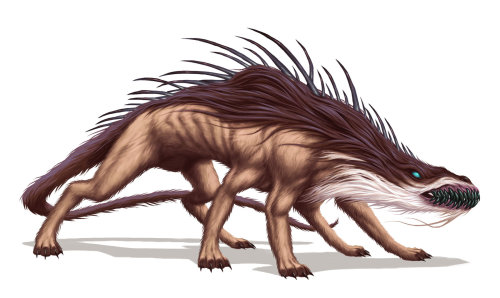Monster Spotlight: Bandersnatch

CR 17
Neutral Gargantuan Magical Beast
Pathfinder Bestiary 3, pg. 32~33
These huge, catlike creatures are labeled as Magical Beasts, but are actually creatures from the primal world of the fae, part of the group collectively known as Tane along with the Jubjub Bird from quite a while ago. They are incorrigible, relentless hunters that stalk their targeted prey eternally until either it dies or they do, retreating only to make use of its Fast Healing 10 and its Quick Recovery (detailed below) to heal up before diving right back into the fray. The only way to shake a Bandersnatch off your trail without killing it is to leave the plane forever, because otherwise they are the trope Super-Persistent Predator to the most extreme and terrifying degree possible.
Aiding in finding prey worthy of its attention is a staggering amount of sensory abilities: Scent, Darkvision 120 feet, Blindsense 120 feet, and even the humble low-light vision to assure it can spot its prey through anything, even if they go invisible or somehow blind the hunter. With Relentless Tracker it can move at up to 120 feet each round without the possibility of losing its target’s trail, even getting a +10 bonus to Survival checks when looking for any creature that it has personally wounded. Once it’s in prime position to pounce, Bounding Charge lets it move without penalty even through thick vegetation or other difficult terrain when it charges straight at them.
Once it has gotten up close and personal, that’s when the horror truly begins. As a full attack the Bandersnatch can strike with its bite (2d8+13 plus grab), two claws (2d6+13 each), and slap with its tail (2d8+13), but each of those attacks has a painful secondary effect even when used as single attack actions. Being grabbed with its bite opens up a target to being Raked by four claw attacks (in addition to the bite damage) the next round if they don’t manage to break the grapple. Being hit by two claws in the same round causes Rend to trigger for an additional 2d6+13 damage. And being hit with the tail? Hoo boy. Being critical hit with that tail deals triple damage rather than double, and with Bleeding Critical and Tiring Critical, once you’re hit you stay hit. Not only that, but the quills that cover the Bandersnatch’s body also coat its tail, and being hit with that tail causes several of them to break off in the skin like porcupine quills, causing immense, crippling pain until they’re removed (which has a chance of dealing even more damage).
Being in melee with one of these is inadvisable yet unavoidable, but fighting back is more difficult than it has to be. The mentioned quills, again, cover the Bandersnatch’s body. and hitting the creature with a melee weapon gets you jabbed by its Quill Defense for 1d10 damage and a chance of having the quills break off in the skin and cause that same sickening pain. Crippling a Bandersnatch with debuffs or ability damage to make it easier to manage is a temporary measure, because Quick Recovery automatically ends a long list of conditions on it at the end of each of its turns and allows it to make saves every round to shrug off ability damage, ability drain, and any mind-affecting effects.
Also, back on the topic of offense: with Lash Out a Bandersnatch can make a single attack each round as a
swift action. Even if it has to waste time getting into range it can
still attack, making kiting it around all the more aggravating.
Provided it just doesn’t launch a volley of Quills to keep its targets from running away, striking up to four targets (or one target four times) from up to 300 feet away with its quills, each dealing 1d10+13 damage and… Yeah, you guessed it, having the same chance to lodge into the body and inflict the sickened condition, just like getting hit with the tail or going in for a hug.
You really, really do not want one of these after you, is what I’m saying. You also really, really do not want to make any Old Fae angry, because it’s likely they’ll have at least one of these horrors at their beck and call.
















